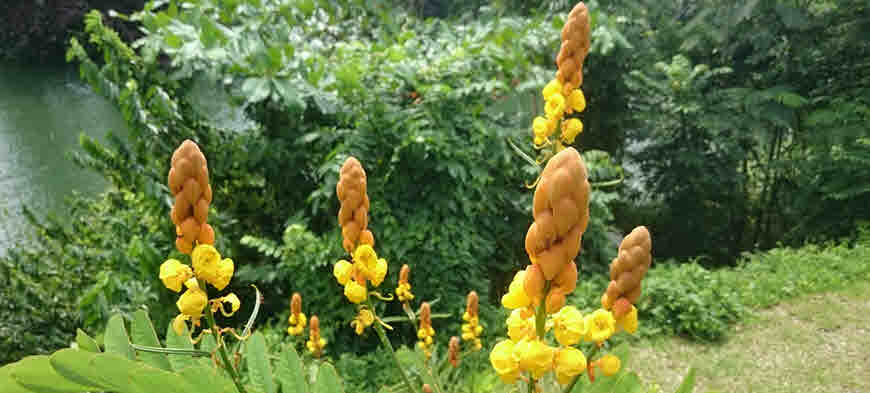Cassia alata is a medicinal plant found growing in open wastelands near watery places. It is native to Southern North America, and was introduced in India. It is commonly known as Ringworm Bush, Dadrughna, Dadmardan, Dadmari (Daad=Ringworm), etc. due to its effectiveness against ringworm.

Cassia alata is one of the oldest known medicinal plant of Central America where people used it for curing skin diseases, worms, fever, bites of insects, etc. It is used throughout Asia Pacific to treat ringworms, goiter, hook worm infestation, sexually transmitted diseases, constipation, and other skin diseases.
General Information
Cassia alata is a medium growing, soft wooded shrub reaching up to height of 6-8 feet. Its leaves are paripinnately compound with leaflets 8-14 pairs, 3-19 x 2.7-5.7 cm, oblong from an oblique base, entire, obtuse or retuse.
Flowers are bright yellow, and are present in racemes. The fruits of the plant are present in winged flat black pods. Seeds are quadrangular, and of 6-8 x 4.5-5.5 mm in size.
Scientific Classification
The botanical name of Ringworm Bush is Cassia alata. Its synonym is Senna alata (L.) Roxb. It belongs to plant family Caesalpiniaceae. Below is given taxonomical classification of the plant.
- Kingdom: Plantae – Plants
- Subkingdom: Tracheobionta – Vascular plants
- Superdivision: Spermatophyta – Seed plants
- Division: Magnoliophyta – Flowering plants
- Class: Magnoliopsida – Dicotyledons
- Subclass: Rosidae
- Order: Fabales
- Family: Fabaceae ⁄ Leguminosae – Pea family (Leguminosae is further divided into three sub-families viz. Papilionoideae, Caesalpinioideae, and Mimosoideae)
- Genus: Senna Mill. – senna Genus: Senna Mill. – senna
- Species: Senna alata (L.) Roxb. – Emperor’s candlesticks
Synonyms
Herpetica alata (L.) Raf.
Senna alata (L.) Roxb.
Part(s) used for medicinal purpose: Leaves, root bark, flowers
Plant type: Bush
Distribution: Found throughout India. Grows wild in wet places but is also cultivated as ornamental plant in gardens
Habitat: Humid, and sub humid tropics, and on range of soils
Flowering and fruiting: September to February
Vernacular Names/Synonyms
- Latin name: Cassia alata
- Ayurvedic: Dadrughna, Dadrumardana
- Siddha: Malanthakerai, Seemaiagathi
- English: Ringworm Shrub, Ringworm Bush, Ringworm Senna, Broad-leaved Cassia, Ringworm cassia, Candle Bush (due to long terminal-auxillary racemes of golden flower), Emperor’s candlestick, King-of-the-forest
- Folk: Daadmaari
- Bengali: Dadmardan, Dadmari
- Chakma: Dadgach, Dattalong Gach, Dattalong Pada, Dhelong Pata, Dodolong Gach, Kabongfah;
- Marma: Pouichibang, Pui Chi, Puiho Chiho, Sangko Maijiri, Pou Chi
- Tripura: Khach Kochak, Khashabubaong, Khasowa
- Khumi: Ciklaikinga
- Tamil: Wandu-kolli, semaiagathi
- Myanmar name: Thinbaw – mezali
- Japan: Hane-senna
- Malaya: Gelenggang, Daun Kurap
- Bolivia: Kota-kota, Yunka mutuillu
- Sri Lanka: Ath-thora
Constituents of Cassia alata
Leaves contain essential oil (composed of sesquiterpene, and phenolic compounds, xanthone, cassiollin, and kaempferol, 6-OH-musizin glycoside, and tinnevellin glycoside). Roots contain quinine pigments. Leaves, and fruits contain anthraquinone glycosides, chrysophanol, emodin, rhein, aloe-emodin, and chrysophanic acid. Young pods contain rhein, emodin, and aloe-emodin.
Important Medicinal Properties
Cassia alata is rich in medicinal properties. The understanding of these properties will help us to better utilize this herb. These also indicate the conditions in which we should avoid it. For example, it has Abortifacient action, and therefore should not be taken internally in pregnancy.
Below is given medicinal properties along with the meaning.
- Abortifacient: induces abortion.
- Antibacterial: active against bacteria.
- Anthelmintic: expel parasitic worms (helminths), and other internal parasites from the body.
- Antihistaminic: inhibit the action of histamine in the body by blocking the receptors of histamine.
- Anti-asthmatic: treat or prevent asthma attacks.
- Antiseptic: Capable of preventing infection by inhibiting the growth of infectious agents.
- Antifungal / fungicidal – biocidal chemical compounds used to kill or inhibit fungi or fungal spores.
- Diuretic: Promoting excretion of urine/agent that increases the amount of urine excreted.
- Laxative: tending to stimulate or facilitate the evacuation of the bowels.
Medicinal uses of Candle Bush / Ringworm Shrub / Cassia alata / Daadmaari
Senna alata is used traditionally to treat ringworm. Ringworm is a common fungal infection that can cause a red or silvery ring-like rash on the skin. It can occur on any part of the body. Ringworm is a contagious infection, and can spread from on person to other by sharing contaminated clothes, towels, direct contact, etc.
Asthma, Constipation
Make tea like preparation by pouring one cup of boiling water on one teaspoon of dried leaves of the plant. Filter after 10 minutes, and drink before going to bed.
Constipation, as laxative
The dried flower is ground, and taken with honey to treat constipation.
Diarrhea, flatulence, poor appetite
Decoction of bark is taken with jaggery.
Eczema (Kanda or Kitibh in Ayurveda), herpes (Kaksha)
Eczema is also known as Atopic Dermatitis. It is a non-contagious skin condition in which there are dry, itchy, rashes on the face, inside the elbows, behind the knees, and on the hands, and feet.
In eczema, the leaf paste is applied externally on the affected area.
Ringworm (Dadru), poisonous insect bites, blotch, washer man’s itch
- The leaves are bruised, and simply rubbed.
- Juice of the leaves, mixed with lemon juice can be applied on the affected area for 2-3 times a day. The poultice of flowers is also used for same purpose.
- The leaves are washed, and crushed to extract the juice. First the area is washed with plain water, and then a layer of leaf juice is applied twice a day for one weak.
Skin disorders
The paste of pounded leaves, and vegetable oil is applied externally.
Insomnia, palpitation, and over sweating
The decoction is taken orally for insomnia, palpitation, and over sweating.
The Dosage of Cassia alata
The Dried powder of leaf or flower is taken in a dose of 3 to 5 grams.
Warning
- Don’t use in pregnancy.
- Always wash the plant part thoroughly before use.